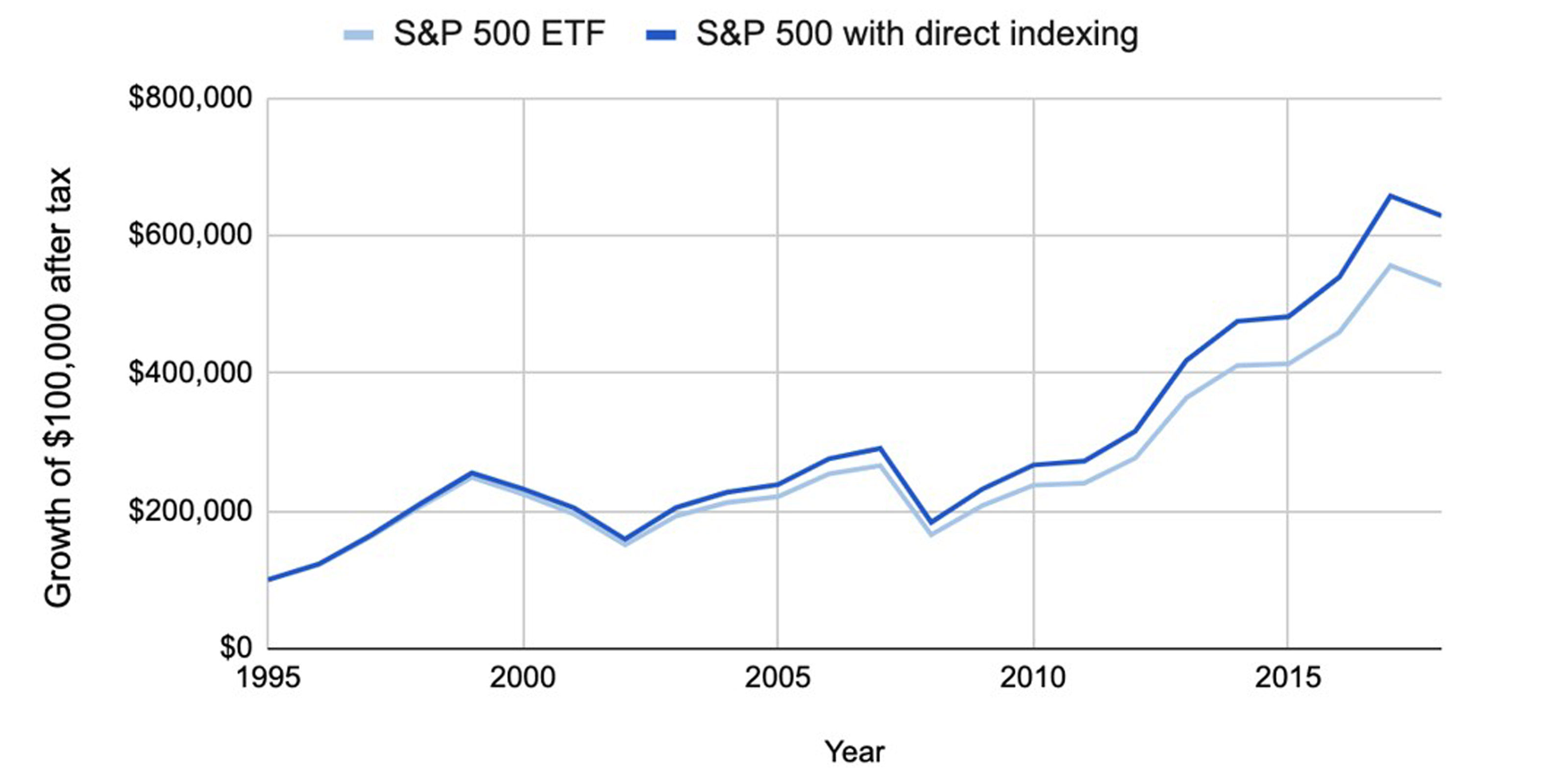Move Over ETFs: Direct Indexing Is an Investment Strategy Worth Paying Attention to
More flexibility, more control, the potential for higher returns and tax-reducing strategies: With pros like that, could direct indexing be right for you?


Recently, direct indexing, a lesser-known investment approach, has started outpacing both ETFs and mutual funds in investor adoption. Direct indexing offers unique benefits that can’t be replicated in a traditional ETF or mutual fund structure, particularly around personalization and tax management.
Given its benefits, direct indexing is expected to continue to outpace ETF and mutual fund growth over the coming years according to a recent Cerulli report. Here’s what you need to know about this growing investment method.
What is direct indexing?
Direct indexing is an investment strategy where an investor holds individual stocks that make up an index in their own account directly, instead of using a mutual fund or ETF to track the underlying index. Similar to an index fund, the goal is to track the performance of a target benchmark index. However, when an investor holds the individual securities directly in their account, it allows for more personalization and the potential for greater tax benefits.
From just $107.88 $24.99 for Kiplinger Personal Finance
Become a smarter, better informed investor. Subscribe from just $107.88 $24.99, plus get up to 4 Special Issues

Sign up for Kiplinger’s Free Newsletters
Profit and prosper with the best of expert advice on investing, taxes, retirement, personal finance and more - straight to your e-mail.
Profit and prosper with the best of expert advice - straight to your e-mail.
Direct indexing has been the core of many high-net-worth clients’ strategies for decades. It’s no surprise, given its unique benefits, particularly around taxes. Offered mostly through financial advisers, investment minimums for direct indexing are often $250,000 or more. However, no-commission trading and fractional shares have made the strategy more broadly accessible, with minimums at or below $5,000 in some cases.
A lower tax bill
With hundreds of individual stocks held in a direct indexing portfolio, there are extensive opportunities for tax loss harvesting – the practice of selling a security at a loss to offset capital gains. Even in up markets, individual stocks can have bouts of poor performance. Direct indexing portfolios can take full advantage, harvesting losses in underperforming stocks even as the market as a whole is up. This can mean 1% or more in additional after-tax returns, according to recent research from Vanguard.
A separate study looked at historical returns over the last century and found that direct indexing added 1.08% annually in after-tax returns. From 1995 to 2018, the most recent period studied, an investor using a direct indexing strategy to track the S&P 500 would have seen their $100,000 initial investment grow to about $630,000 after accounting for taxes. That’s $101,000 more than they otherwise would have had.
Note: The dark blue line in the graph represents the after-tax value of a portfolio that tracks the S&P 500 using direct indexing and employs a tax loss harvesting strategy. By comparison, the light blue line represents the after-tax value of an ETF that tracks the S&P 500.

Sources: Chaudhuri, Burnham, Lo 2020; author’s calculations.
The flexibility of direct indexing also allows for portfolios to be built around existing holdings. This becomes particularly important when a portfolio has embedded gains in concentrated positions. In such a case, an investor can diversify around existing positions while managing any potential tax impact from liquidating positions.
Pinpoint personalization
By holding securities in their own accounts, investors are free to customize portfolios as they see fit. Such customization is not possible in a fund, as each investor has exposure to the same set underlying securities as every other shareholder.
Direct indexing portfolios can tilt toward ESG factors, or exclude securities that do not align with an investor’s values. Because this can be done at the individual account level, investors don’t need to compromise on their values when building their portfolio. Additionally, holding individual stocks allows shareholders to participate directly in proxy voting, another source of control for investors.
Personalization affords another important benefit: better behavior. It’s often easier to not overreact in a down market and stick to a savings plan when your investments reflect your values.
Too much personalization, however, can cause direct index performance to deviate – positively or negatively – from the target index. Every investor has their own tolerance for risk and performance, and investors should be aware that there is a tradeoff between customization and tracking the benchmark index.
Is direct indexing right for me?
One of the main advantages of direct indexing is that it can generate additional capital losses. Capital losses are most useful when an investor has capital gains to offset from other investments. For investors with little or no outside capital gains, the tax benefits afforded are more limited.
Additionally, direct indexing has more moving parts than a portfolio that uses funds. Holding individual securities and trading them for tax loss harvesting means more transactions to account for at tax time.
For many, direct indexing will be the future of investing
Direct indexing strategies are growing faster than other investment vehicles. And for good reason, the strategy offers benefits that are difficult or impossible to replicate using a fund. Recent innovations, like fractional share trading, have lowered the barrier to entry to direct indexing portfolios.
A once rarified investment strategy is now poised for broader adoption and with it the potential to generate better outcomes for many investors.
Profit and prosper with the best of Kiplinger's advice on investing, taxes, retirement, personal finance and much more. Delivered daily. Enter your email in the box and click Sign Me Up.

Adam Grealish serves as Head of Investments at Altruist, a fintech company on a mission to make great independent financial advice more affordable and accessible. With a career rooted in financial innovation, Adam most recently led Betterment's strategic asset allocation, fund selection, automated portfolio management, and tax strategies. In addition, he served as a vice president at Goldman Sachs, overseeing the structured corporate credit and macro credit trading strategies.
-
 7 Retirement Planning Trends: What They Mean for You in 2026
7 Retirement Planning Trends: What They Mean for You in 2026From government shutdowns to market swings, the past 12 months have been nothing if not eventful. The key trends can help you improve your own financial plan.
-
 What Defines Wealth? A Christmas Tale of Legacy vs Possession
What Defines Wealth? A Christmas Tale of Legacy vs PossessionThe tale of Good King Wenceslas shows that true wealth is built through generosity, relationships and the courage to act kindly no matter what.
-
 5 Moves to Ensure the Markets Work Hard for You in 2026
5 Moves to Ensure the Markets Work Hard for You in 2026After a strong 2025 in the stock market, be strategic by rebalancing, re-investing with a clear purpose and keeping a disciplined focus on your long-term goals.
-
 7 Retirement Planning Trends in 2025: What They Mean for Your Wealth in 2026
7 Retirement Planning Trends in 2025: What They Mean for Your Wealth in 2026From government shutdowns to market swings, the past 12 months have been nothing if not eventful. The key trends can help you improve your own financial plan.
-
 What Defines Wealth: Soul or Silver? Good King Wenceslas' Enduring Legacy in the Snow
What Defines Wealth: Soul or Silver? Good King Wenceslas' Enduring Legacy in the SnowThe tale of Good King Wenceslas shows that true wealth is built through generosity, relationships and the courage to act kindly no matter what.
-
 An Investing Pro's 5 Moves to Help Ensure 2025's Banner Year in the Markets Continues to Work Hard for You in 2026
An Investing Pro's 5 Moves to Help Ensure 2025's Banner Year in the Markets Continues to Work Hard for You in 2026After a strong 2025 in the stock market, be strategic by rebalancing, re-investing with a clear purpose and keeping a disciplined focus on your long-term goals.
-
 The Santa Claus Rally Officially Begins: Stock Market Today
The Santa Claus Rally Officially Begins: Stock Market TodayThe Santa Claus Rally is officially on as of Wednesday's closing bell, and initial returns are positive.
-
 Introducing Your CD's Edgier Cousin: The Market-Linked CD
Introducing Your CD's Edgier Cousin: The Market-Linked CDTraditional CDs are a safe option for savers, but they don't always beat inflation. Should you try their counterparts, market-linked CDs, for better returns?
-
 'Humbug!' Say Consumers, Despite Hot GDP: Stock Market Today
'Humbug!' Say Consumers, Despite Hot GDP: Stock Market Today"The stock market is not the economy," they say, but both things are up. Yet one survey says people are still feeling down in the middle of this complex season.
-
 How to Protect Yourself and Others From a Troubled Adult Child: A Lesson from Real Life
How to Protect Yourself and Others From a Troubled Adult Child: A Lesson from Real LifeThis case of a violent adult son whose parents are in denial is an example of the extreme risks some parents face if they neglect essential safety precautions.
-
 To Build Client Relationships That Last, Embrace Simplicity
To Build Client Relationships That Last, Embrace SimplicityAs more automation becomes the norm, you can distinguish yourself as a financial professional by using technology wisely and prioritizing personal touches.